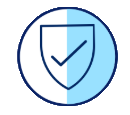Learn About Open-Source Blockchain Technologies
Learning Objectives
After completing this unit, you’ll be able to:
- Explain the business benefits of blockchain.
- Explain IBM’s point of view on blockchain.
We’re moving right along! In the previous unit, we talked about how blockchain works in business. But what’s in it for you?
The Business Benefits of Blockchain

Stronger Capital Flow
Contracts that are executed using blockchain are automated and final. Businesses benefit from increased speed of execution, reduced costs, and less risk—all of which enables them to foster better relationships with customers and build new revenue streams.

Better Processes
As mentioned in the first unit, in traditional business networks all participants maintain their own ledgers with risk of duplication and discrepancies. By using blockchain, where transactions cannot be altered once consensus is reached, businesses can save time and costs while reducing risks.

Security and Trust
Blockchain consensus provides the benefit of a consolidated, consistent dataset. And because information contained in the shared ledger is not controlled by any single party, blockchain leads to increased trust and integrity in the flow of transaction information.
IBM’s Open Source Point of View
In 2015, a group of companies (including IBM) decided that none of the existing blockchain technologies were really suitable for the enterprise. So, they formed the Hyperledger Project in order to build a new platform with enterprise requirements in mind—a blockchain that could be used in highly regulated environments with the values of being distributed, permissioned, and secure front and center.

As with the Apache server and the Linux kernel, the Hyperledger Project recognized that a technology this important should not be controlled by any single vendor. It would never be successful if it were just available from one company. So they worked together to establish Hyperledger, the fastest-growing project at the Linux Foundation ever.
Are you as excited to see how blockchain works in a business scenario as we are? That’s what we’ve got for you in the next unit. See you there after the quiz.
Resources
